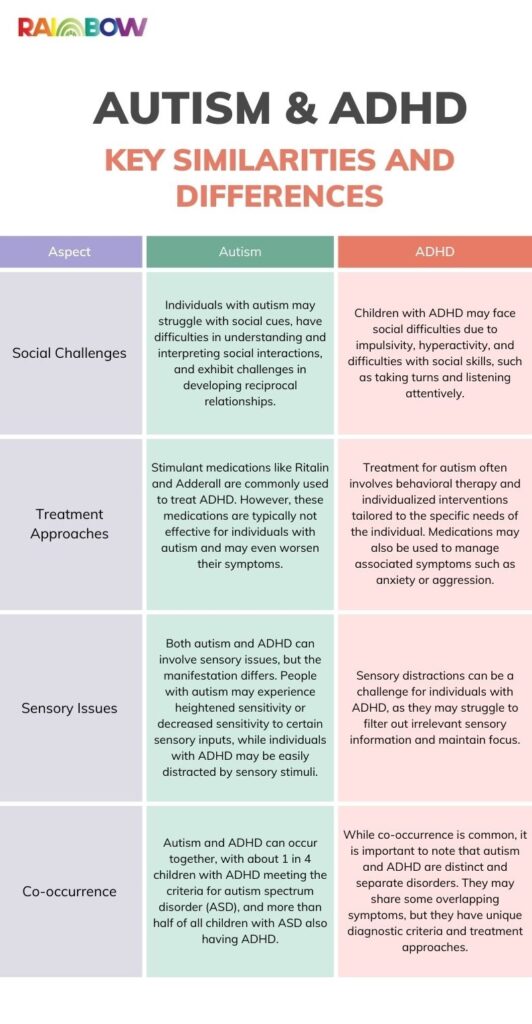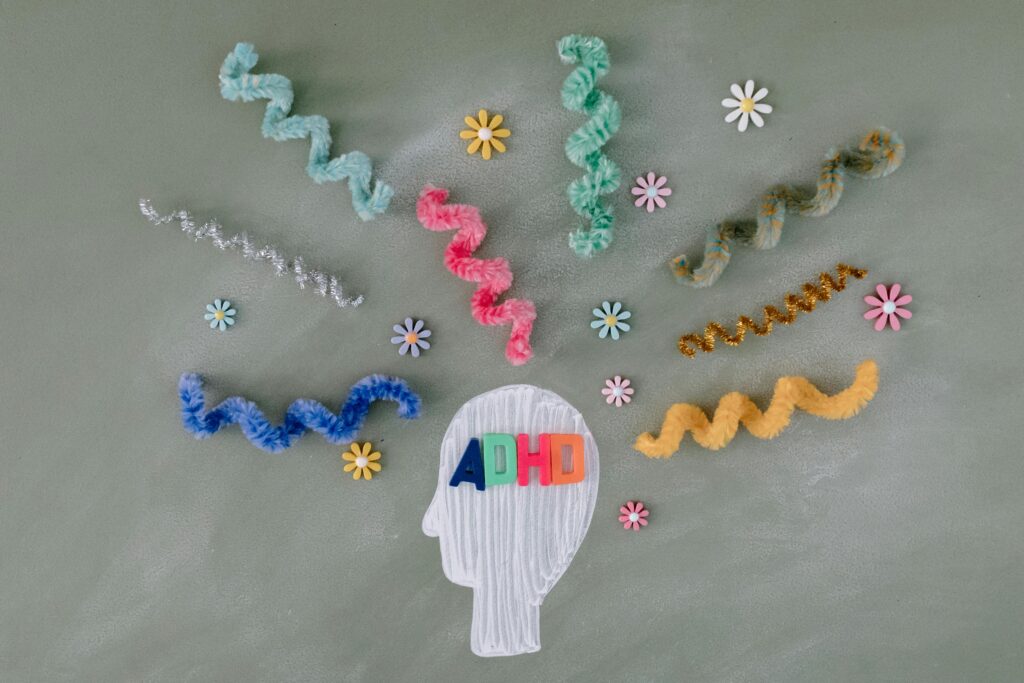To gain a better understanding of the key similarities and differences between autism and ADHD, it is essential to first grasp the individual characteristics of each condition.
What is Autism?
Autism, also known as autism spectrum disorder (ASD), is a neurodevelopmental disorder that primarily affects social communication and interaction. Individuals with autism may have difficulties with verbal and nonverbal communication, social cues, and developing and maintaining relationships. They may also exhibit repetitive behaviors and have intense interests in specific topics or activities.
What is ADHD?
ADHD, which stands for attention-deficit/hyperactivity disorder, is another neurodevelopmental disorder accompanied with recurring patterns of hyperactivity, inattention, and impulsivity. People with ADHD may struggle with maintaining attention, following instructions,organizing tasks, and controlling impulsive behaviors. They may also display high levels of physical activity and restlessness.
Key Similarities and Differences
While autism and ADHD share some similarities, it is important to recognize their distinct characteristics. Here are some key points to consider:

Understanding the similarities and differences between autism and ADHD is crucial for accurate diagnosis and appropriate interventions. If you suspect that you or your child may have ADHD, autism, or both, it is important to seek professional evaluation and guidance. Early diagnosis and intervention can significantly improve outcomes and help individuals with these conditions thrive.
Social Challenges
When comparing autism and ADHD, it’s important to understand the social challenges that individuals with these conditions may face. While both conditions can impact social interactions, they do so in different ways. Let’s explore how autism and ADHD affect social cues and impulsivity.
Autism and Social Cues
One of the hallmark characteristics of autism is difficulty with social communication and interaction. Individuals with autism may struggle to understand and interpret social cues, such as body language, facial expressions, and tone of voice. They may find it challenging to recognize and respond appropriately to social cues, which can affect their social relationships.
Social challenges in autism can manifest in various ways. For example, individuals with autism may have difficulty initiating or sustaining conversations, interpreting sarcasm or humor, or understanding non-literal language. They may also struggle with perspective-taking and understanding others’ emotions or intentions.

ADHD and Impulsivity
In contrast, individuals with ADHD may experience social challenges primarily related to impulsivity and hyperactivity. Impulsivity refers to acting without thinking, often interrupting others or speaking out of turn. This impulsive behavior can make it challenging for individuals with ADHD to engage in appropriate social interactions and adhere to social norms.
Hyperactivity, another characteristic of ADHD, can also impact social interactions. Restlessness and difficulty staying still can make it hard for individuals with ADHD to engage in activities that require focused attention or participate in social situations that demand calm and quiet behavior.
While social challenges exist in both autism and ADHD, the underlying mechanisms and specific difficulties can vary. Understanding these differences can help parents, caregivers, and educators provide appropriate support and interventions tailored to the specific needs of individuals with autism and ADHD.
Diagnosis and Age of Onset
When it comes to diagnosing neurodevelopmental disorders like ADHD and autism, there are specific criteria and guidelines that healthcare professionals follow. While these conditions can often coexist, it’s important to understand the differences in the diagnostic process for each.
Diagnosing ADHD
ADHD can be diagnosed as early as a4 years old. The diagnostic process for ADHD involves a comprehensive assessment that considers the individual’s behavior and symptoms across multiple settings, such as home and school.
To diagnose ADHD, healthcare professionals rely on criteria outlined in the Diagnostic and Statistical Manual of Mental Disorders (DSM-5). These criteria include symptoms of inattention, hyperactivity, and impulsivity that are persistent and impairing. The symptoms must also be present before the age of 12 and be present in two or more settings.
During the evaluation, healthcare professionals may use various assessment tools, interviews, and questionnaires to gather information from parents, teachers, and the individual themselves. This comprehensive approach helps ensure an accurate diagnosis and appropriate treatment plan.
Diagnosing Autism
Autism can be diagnosed at an earlier age– about 14 to 16 months. The diagnostic process for autism involves a thorough evaluation of an individual’s social communication, behavior, and development. Healthcare professionals consider criteria outlined in the DSM-5 to make an accurate diagnosis.
Autism primarily affects social communication and interaction, and individuals with autism may exhibit restricted and repetitive patterns of behavior. The diagnostic evaluation for autism often involves gathering information from parents, caregivers, and teachers, as well as direct observation of the individual’s behavior and interactions.
In addition to the DSM-5 criteria, healthcare professionals may also use standardized assessment tools, such as the Autism Diagnostic Observation Schedule (ADOS), to aid in the diagnosis. These tools provide a structured framework for evaluating social communication and behavior.
It’s worth noting that autism and ADHD can occur together. However, it’s important to recognize that these are distinct and separate disorders, each with their own set of characteristics and diagnostic criteria.
Seeking early diagnosis for children with ADHD or autism is crucial for effective management of the conditions. The involvement of healthcare professionals, such as doctors or pediatricians, is recommended to ensure timely intervention and appropriate support. Undiagnosed and untreated ADHD or autism can pose risks, so it’s essential to address any concerns and seek professional guidance.

Repetitive Behaviors
Repetitive behaviors are a characteristic feature of both autism and ADHD, but they manifest differently in each condition. Understanding these differences can help in distinguishing between autism and ADHD, as well as in guiding appropriate interventions.
Repetitive Behaviors in Autism
In individuals with autism, repetitive behaviors often take the form of repetitive movements or activities, commonly known as “stimming.” Stimming can include actions such as hand flapping, rocking back and forth, or spinning in circles. These behaviors serve various purposes for individuals with autism, such as self-soothing, regulating sensory input, or expressing excitement.
It is important to note that not all individuals with autism engage in stimming behaviors. The presence and nature of repetitive behaviors can vary widely among individuals on the autism spectrum. Some individuals may exhibit highly repetitive behaviors, while others may have more subtle or infrequent repetitive actions.
Task Switching in ADHD
In contrast to autism, individuals with ADHD are more likely to exhibit difficulties with task switching rather than engaging in repetitive behaviors. They may struggle with shifting attention from one task to another, leading to challenges in maintaining focus and completing tasks efficiently.
Children with ADHD often display hyperactivity and impulsivity, which can make it challenging for them to stay engaged in a single task for an extended period. They may frequently switch activities or become easily distracted by external stimuli. This difficulty in task switching can impact their productivity and overall performance.
Understanding the differences in repetitive behaviors between autism and ADHD is essential for accurate diagnosis and appropriate management. However, it is important to note that while these behaviors are characteristic of each condition, there can be some overlap in symptoms. This overlap can sometimes lead to misdiagnosis or challenges in distinguishing between the two conditions. Consulting with a healthcare professional who specializes in neurodevelopmental disorders can help in obtaining a comprehensive evaluation and accurate diagnosis.
Treatment Approaches
When it comes to addressing the challenges associated with autism and ADHD, different treatment approaches are employed. It’s important to note that while some treatments may overlap, there are also distinct differences in the approaches taken for each condition.

Medication for ADHD
In the case of ADHD, medication is a commonly utilized treatment approach. Stimulant medications like Ritalin and Adderall are often prescribed to help manage the symptoms of ADHD. These medications work by increasing the levels of certain neurotransmitters in the brain, which can improve attention, focus, and impulse control.
It’s important to consult with a healthcare professional to determine the appropriate medication and dosage for an individual with ADHD. Regular monitoring and adjustments may be necessary to ensure optimal effectiveness and minimize potential side effects.
Treatment Challenges in Autism
When it comes to treating autism, the approach can be more complex due to the broad range of symptoms and challenges individuals may experience. While there is no cure for autism, a combination of therapies and interventions can help individuals manage their symptoms and improve their overall quality of life.
Behavioral therapy, such as Applied Behavior Analysis (ABA), is often a cornerstone of treatment for individuals with autism. This therapy focuses on teaching and reinforcing positive behaviors while reducing challenging behaviors. Other therapies, such as speech therapy, occupational therapy, and counseling, may also be recommended depending on the specific needs of the individual.
In addition to therapy, medication may be prescribed to address specific symptoms or co-occurring conditions that may be present in individuals with autism. It’s important to note that while stimulant medications like Ritalin and Adderall are commonly used to treat ADHD, they are not usually helpful for individuals with autism and may even worsen symptoms. Therefore, medication options for autism are typically different from those used for ADHD.

Sensory Issues
Sensory issues are common in both autism and ADHD, although the way these issues manifest can differ between the two conditions. In autism, individuals may experience sensory sensitivities, while in ADHD, sensory distractions can significantly impact attention and focus.
Sensory Sensitivities in Autism
Sensory sensitivities are a hallmark feature of autism, with individuals often experiencing heightened or diminished responses to sensory stimuli such as sounds, lights, textures, or smells. These sensitivities can impact daily functioning and contribute to sensory-related behaviors or preferences.
Autistic individuals may be oversensitive or undersensitive to certain sensory inputs. For example, they may find certain sounds or textures overwhelming, while others may seek out intense sensory experiences to regulate their sensory input. These sensory sensitivities can affect various modalities, including auditory, visual, tactile, olfactory, and gustatory.
To address sensory sensitivities in autism, it is important to create a sensory-friendly environment. This can include providing a quiet space, using visual supports, minimizing bright lights or loud noises, and offering sensory tools or techniques to help individuals self-regulate.
Sensory Distractions in ADHD
In ADHD, sensory distractions can significantly impact attention, focus, and task completion. Individuals with ADHD may be easily overwhelmed or distracted by external sensory inputs, making it difficult to concentrate on tasks. They may have heightened sensitivity to certain sensory stimuli, such as noise or visual distractions, which can easily capture their attention and disrupt their focus.
Addressing sensory distractions in ADHD involves creating an environment that minimizes sensory overload. This can include minimizing distractions, providing structured routines, and using assistive technologies to support attention and focus. It is also important to provide clear instructions and break tasks into smaller, manageable steps to help individuals stay organized and on track.

Additional Characteristics
In addition to the core features of autism and ADHD, there are additional characteristics that can help differentiate between the two conditions. Understanding these characteristics can provide further insight into the unique challenges faced by individuals with autism and ADHD.
Intense Interests and Organization Challenges
One characteristic commonly associated with autism is the presence of intense interests. Autistic individuals may develop a deep fascination with specific topics or subjects. These interests often become a central focus of their lives, and they may spend extensive amounts of time learning and engaging with these topics. This intense focus can sometimes lead to a wealth of knowledge and expertise in a particular area.
On the other hand, individuals with ADHD may experience challenges with organization and time management. They may struggle with maintaining order and structure in their daily lives, often finding it difficult to keep track of tasks, appointments, and deadlines. This can result in difficulties with planning, prioritizing, and completing tasks in a timely manner.
Emotional Regulation and Social Skills
Emotional regulation and social skills are areas where both autism and ADHD can present unique challenges.
Autistic individuals may have difficulties understanding and expressing emotions, as well as interpreting the emotions of others. They may struggle with recognizing social cues, such as facial expressions and body language, which can impact their ability to form and maintain relationships. Additionally, the use of abstract language and non-literal communication can pose challenges for individuals with autism.
In contrast, individuals with ADHD may struggle with regulating their emotions and impulses. They may experience heightened emotional responses and have difficulty managing their reactions in various situations. This can manifest as impulsive behavior, such as interrupting others or acting without considering the consequences. The ability to focus on tasks and sustain attention can also be challenging for individuals with ADHD.
While there are similarities in the social and emotional challenges faced by individuals with autism and ADHD, the specific nature and manifestation of these difficulties may differ. It is important to recognize that each individual is unique, and the presentation of these characteristics can vary widely.

Individualized Interventions
Individualized interventions are crucial for addressing the specific needs of individuals with autism and ADHD. Each person may present with unique symptoms and challenges, requiring a personalized approach to their treatment.
For autism, individualized interventions may include additional therapies such as counseling, education support, speech therapy, and occupational therapy, depending on the severity of symptoms and the impact on daily life. These interventions aim to address the specific needs of individuals with autism, such as social communication difficulties, sensory sensitivities, and repetitive behaviors.
Similarly, individualized interventions for ADHD may involve a combination of approaches tailored to the individual’s needs. This may include medication to manage symptoms such as inattention, hyperactivity, and impulsivity, as well as behavioral therapy to improve executive functioning skills and behavioral regulation. Establishing routines and providing structure can also be beneficial for individuals with both autism and ADHD.
In both cases, it’s important for treatment plans to be flexible and adaptable, as the needs of individuals may change over time. Regular monitoring and adjustments to the interventions should be made to ensure they remain effective and address any emerging challenges.

Importance of Early Diagnosis
Early diagnosis plays a critical role in providing children with the support and resources they need to thrive. By identifying the signs and symptoms of autism or ADHD at an early stage, parents and caregivers can take proactive steps to address the challenges their child may face. Early intervention can help improve communication skills, social interactions, and overall quality of life for children with these conditions.
Research has shown that early intervention can lead to better long-term outcomes for children with autism or ADHD. It allows for the implementation of targeted therapies and strategies tailored to the individual needs of the child. Early diagnosis also enables parents and caregivers to better understand the condition, access appropriate support services, and connect with other families facing similar challenges.
Undiagnosed or late-diagnosed autism or ADHD can have significant negative impacts on a child’s life. It may result in difficulties at school, strained relationships with peers and family members, and challenges in developing essential life skills.

Involvement of Healthcare Professionals
When seeking early intervention for autism or ADHD, it is crucial to involve healthcare professionals such as doctors or pediatricians. These experts have the knowledge and experience to evaluate and diagnose these conditions accurately. They will do comprehensive evaluations, gather relevant information, and consider the child’s developmental history to make an informed diagnosis.
Healthcare professionals also play a vital role in guiding parents and caregivers through the entire process. They can provide information about available treatment options, therapies, and support services. Additionally, they can offer guidance on managing symptoms, addressing behavioral challenges, and promoting the overall well-being of the child.
Collaboration between parents, caregivers, and healthcare professionals is essential in developing an individualized intervention plan for children with autism or ADHD. This plan may include various strategies such as behavioral therapy, educational support, and specific interventions tailored to the child’s unique needs. By working together,

